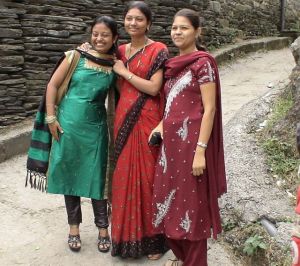As a western woman, I often feel conflicted when I travel in other countries where the men wear western dress,
but their wives wear traditional non-western clothing. I find it especially difficult to understand when the clothing is restrictive and prohibits women from physical activity easily accessible to the men. For example, you can’t drive a motorcycle sitting side saddle. Even driving a car, you have to pull up the saree not to get it caught in the peddles which violates the modesty conventions in India.
That said, I must say that I’m fascinated both by the beauty and other efficiencies of the saree, and curious about its role in tradition.
Think about a long rectangular piece of cloth that can be used to dress any and all women in Indian. How efficient is that? Whether the woman is large, small, old, young, pregnant- anyone could wear that same piece of rectangular cloth. It can be dyed in a variety of different colors, and patterns, decorated with gold threads or embroidered, or just plain. Material can be cotton, silk or even synthetics like polyester. Girls and more modern young women in cities mostly wear kurtas which are long tops over pants in the same colorful patterns as sarees. That amazing efficiency of no “fit issues” goes away in favor of more comfort and accessibility to activities like riding a motorbike that sarees make difficult. And, except for formal occasions, do you really want to dress like your grandmother?
Still, sarees stand out as little islands of beauty in dusty villages along dirt roads with no electricity and a village pump for water. They are functional work clothes in the traditional way of life of the villages where 2/3 of India lives. It would be so much less colorful if the women wore western dress. So, why do the men?

